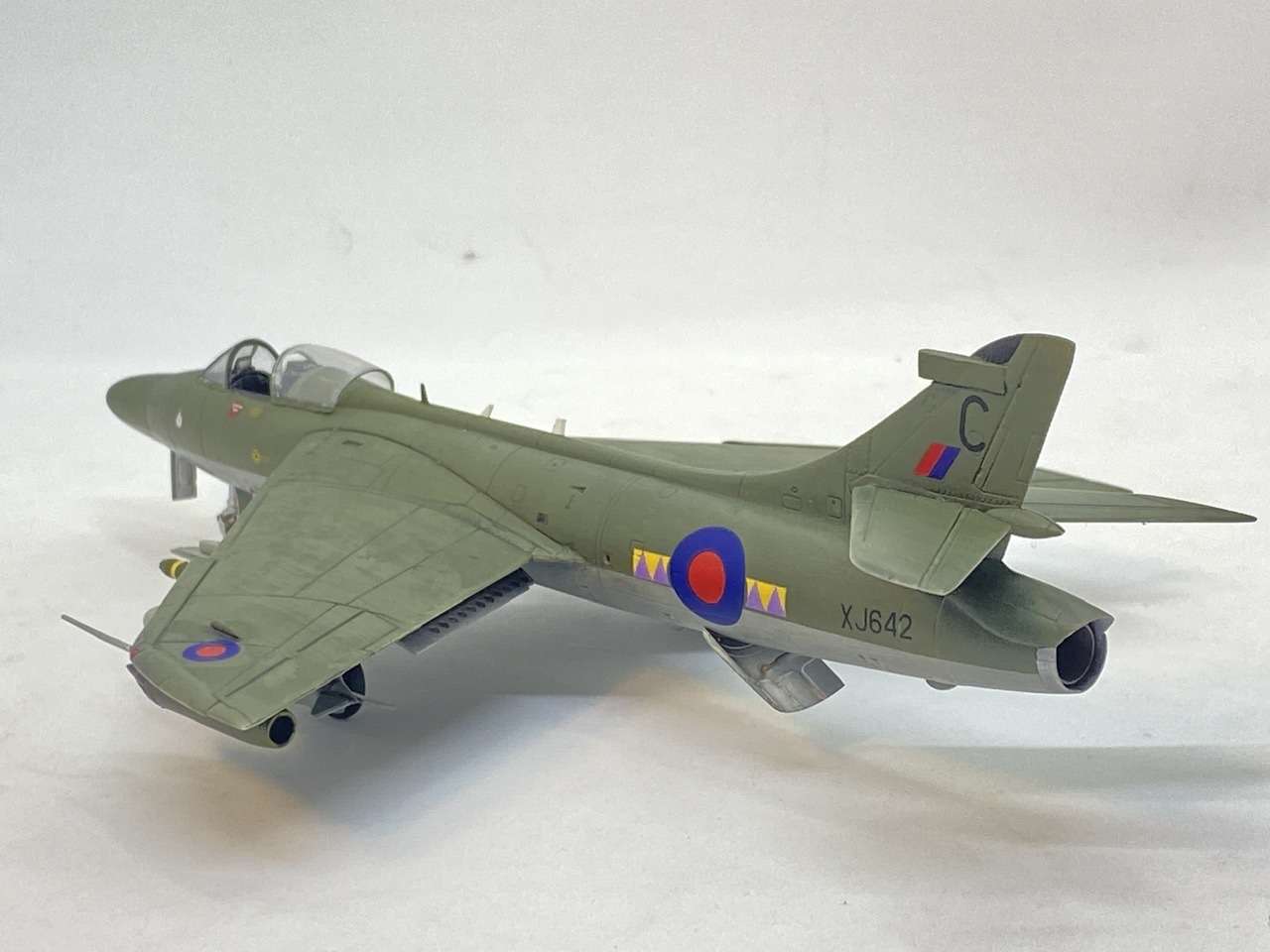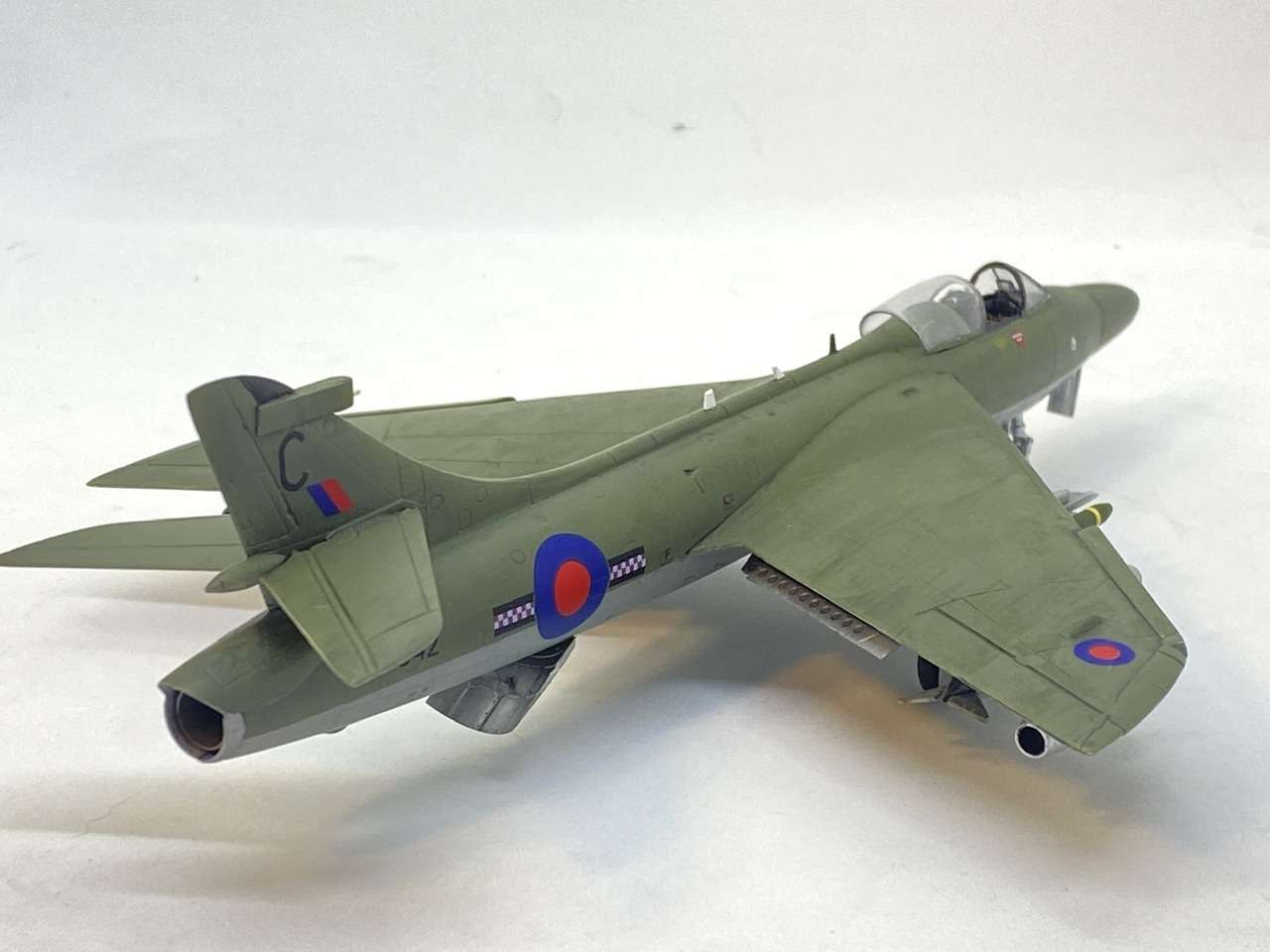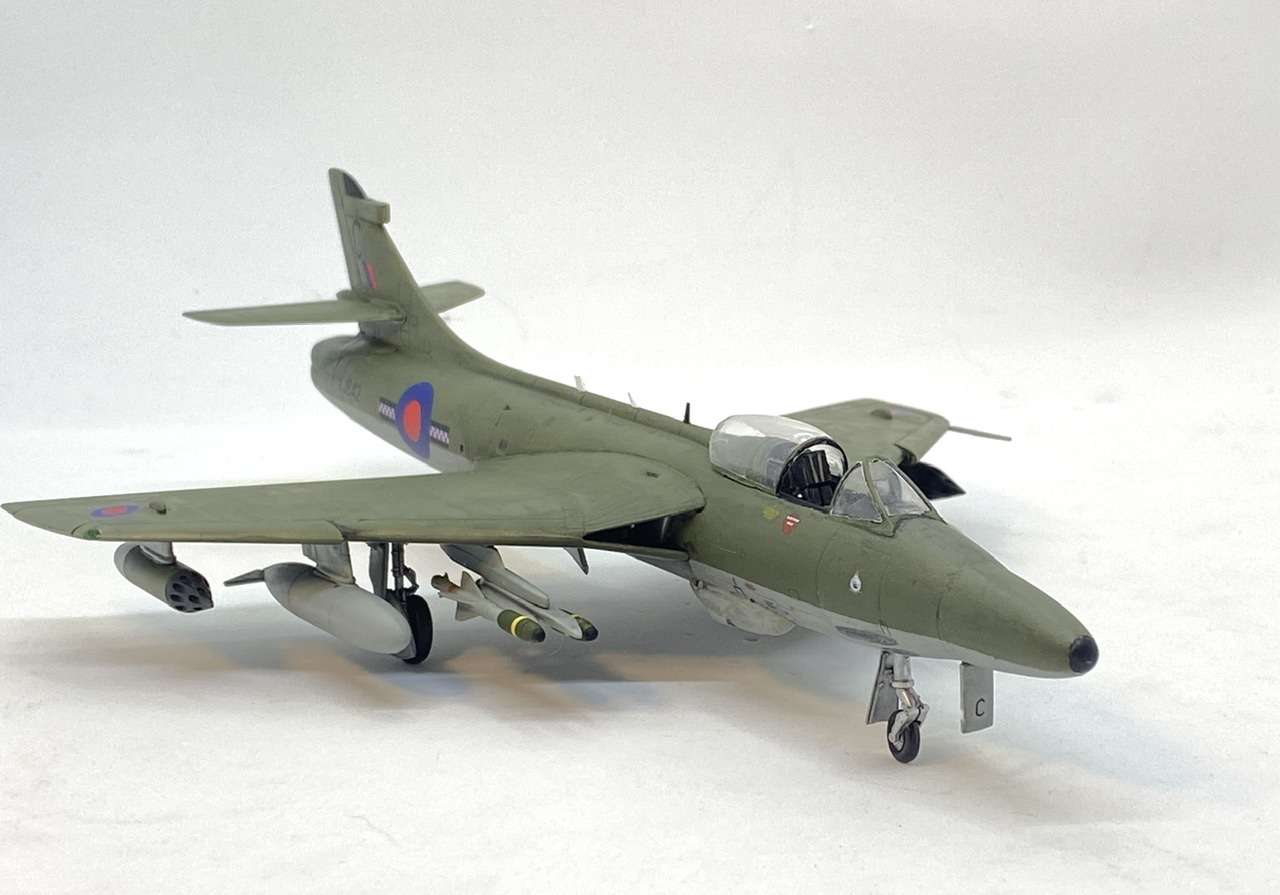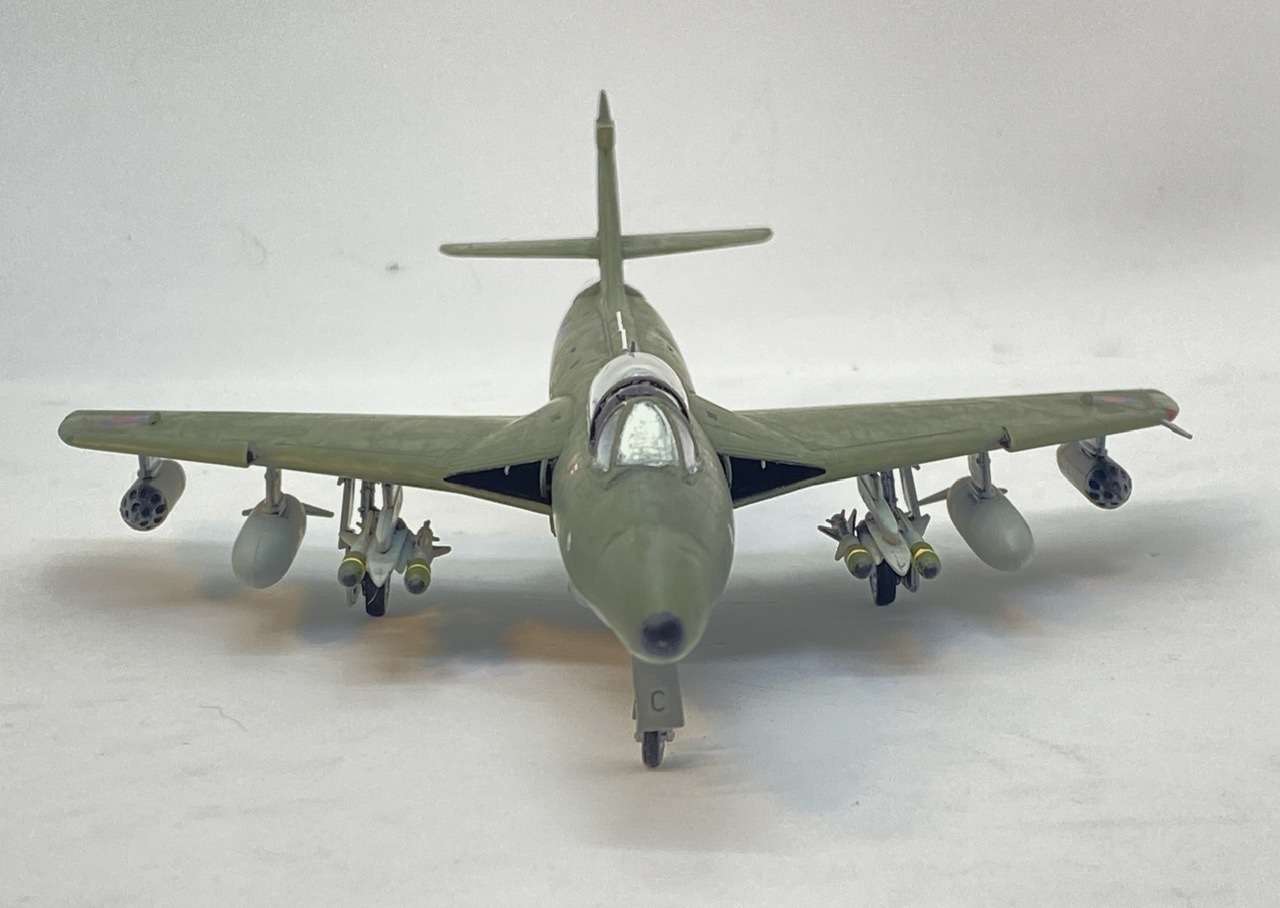The 1979 Soviet invasion and annexation of southeastern Finland was a wakeup call to NATO. With Finland a neutral nation NATO sat on the sidelines as a very interested observer during the brief conflict that saw the USSR take almost 15% of Finland.
Across the alliance there were calls for increased spending and preparedness. In the UK the newly elected Thatcher government struggled both financially and politically to grow the UK armed forces. Several planned cuts were reversed and at the suggestion of a senior RAF officer a decision was made to reactivate Royal Auxiliary Air Force flying squadrons. With flying RAuxAf squadrons eliminated in 1957 this was no small task, but compared to other options it was viewed as viable.
With budgets still limited and rumours of the MoD considering the affordable F-5E, British Aerospace saw an opportunity and submitted a proposal to upgrade a number of Hunter FGA.9s with an avionics suite based on the Harrier GR.3. The Hunter’s gentle and forgiving handling characteristics won over some in the MoD who were concerned about having part-time “Weekend Warriors” flying fast jets.
The resulting Hunter GR.13 entered service in 1983. Upgrades included new avionics and weapons computers including a Ferranti LRMTS, a comprehensive RWR fit and a new HUD. Other cockpit changes included a new control stick grip and throttle incorporating the new HOTAS philosophy, as well as the latest Martin Baker MK.10 zero-zero ejection seat.
The RAuxF Hunter force was envisioned as a highly specialized CAS/Anti-armour force. For this mission the BAe Sabre laser guided anti-tank missile was integrated, with an inner pylon fitted to take the Sabre’s twin launch rail (or an AIM-9 Sidewinder) The GR.13 was also cleared to carry 500 and 1000lb bombs and the Matra 155 rocket pod. Two of the cannons were removed, making room for avionics and also freeing up the aft section of the “Sabrina” ammunition link collectors for the installation of chaff and flare countermeasures. In practice the limited time available for training and proficiency flying meant that the RAuxAF focused almost entirely on deploying Sabre.
The new RAuxAF flying squadron structure was based on two “Wings” of two squadrons each. The Southern Auxiliary Wing was based at RAF Honington and the Northern Auxiliary Wing at RAF Leeming. The Southern Wing comprised 605 (County of Warwick) and 601 (County of London) squadron. The Northern Wing included 603 (City of Edinburgh)and 607 (County of Durham) squadrons. These squadrons were chosen as a cost saving measure after markings for these units dating to the 1950s were found in the RAF Stash at RAF Little Whinging.
Each wing had an assigned wartime base in West Germany where regular training deployments were held. The Southern Wing deployed to RAF Brüggen and the Northern Wing to RAF Laarbruch.
Each squadron operated 12 aircraft for a total Auxiliary force of 48 Hunter GR.13s. Six Hunter T.7s were upgraded to a similar standard for training. Each wing was assigned a single T.14 for currency flights and “Squadron hack”, with the remaining four assigned to the RAuxAF Training Flight at RAF Bawdy. In practice each squadron drew its aircraft from a common Wing pool of 24 aircraft. As part of this arrangement the aircraft were painted in the squadron markings of both squadrons, with one squadron’s bars flanking the roundel on one side and the other squadron on the other. Each squadron’s crest was applied to the appropriate side on the nose. This arrangement led to a great deal of camaraderie and friendly rivalry between the squadrons.
In spite of their part-time “Weekend Warrior” status RAuxAF pilots and ground crew routinely scored highly on RAF and NATO evaluations and their expertise with the Sabre made them an essential part of the NATO ORBAT. Many squadron members were ex-RAF but by no means a majority with approximately 60% having civilian backgrounds. Initial skepticism of these pilots being able to remain proficient in a part-time role proved unfounded, with a rigorous selection process bringing in highly qualified and motivated individuals. For 12 pilots with prior civilian backgrounds the Hunter was their “slow aeroplane” since they flew Concordes full time for British Airways. A similar situation existed on the ground side with one of the 605 Sqn Engineers being a chief design engineer on the RB.199 engine for Rolls Royce and another working on BAe's EAP "Future Fighter" program.
Overall the RAF’s return to part-time combat aircraft operations was seen as a resounding success. But even the upgraded Hunter GR.13 was not going to be able to soldier on forever. This was a situation capitalized on by Northrop in 1986, when facing the cancellation of their promising F-20 program. They took a chance on an order from the US’s closest ally making the F-20 cancellation-proof. They offered F-20s with British engines and avionics at a cut rate price on an effort to save the overall program.
When the British Minister of Defence was first contacted by Northrop he thought the ridiculous accent and even more ridiculous price was his brother-in-law taking the piss. After two more contacts he finally realized it really was a Northrop executive offering the RAuxAF a fleet of 56 F-20A and B models for not much more than the MoD had sunk into the Hunter GR.13 program. The gambit worked and the F-20 entered RAuxAF service in 1992.
The initial IOC of 1991 was delayed a year when a squadron of Hunters deployed as part of Operation Granby, the UK’s contribution to Operation Desert Storm. The Hunter served well in its swan song, with 12 aircraft and crews accounting for 68 Iraqi tanks destroyed with Sabre and 133 other vehicles destroyed with either Sabre or CRV-7 rockets. One GR.13 managed to claim the RAF’s first aerial kill since World War Two when it engaged a MiL-24 helicopter with an AIM-9L Sidewinder.
The F-20 program was saved by Northrop’s savvy move and went on to serve with the RAuxAF and the USAF Reserve and Air National Guard as well as the air forces of Israel, South Korea, Indonesia, Ireland, and Italy.
This aircraft depicts a Northern Wing GR.13 with a live weapons load for an annual live fire exercise. It wears the markings of 607 Sqn on the left side and 603 Sqn on the right. It carries a typical warload of 4x Sabre anti-tank missiles and two Matra 155 rocket pods for soft targets. It also carries 100 gallon drop tanks on the middle pylons. Other less commonly carried GR.13 loads were 8x Sabre missiles or 4x Sabre plus 2x AIM-9L. Though the superfluous cannon ports were retained, only two ADEN cannon are fitted, with 170 rounds each for this live exercise.
This aircraft, XJ642 is now on display in its Desert Pink “Granby” camouflage at the Scottish National Museum Of Flight at East Fortune, just outside Edinburgh.






The kit is one many will recognize as the nice 1/72 Revell FGA.9. The LRMTS nose is fashioned from the aft end of an Academy 1/48 Hunter FGA.9 230 gal drop tank. Somewhat poetically of the several tanks I looked at the Hunter one had the right look for a Harrier GR.3 style LRMTS nose. Chaff/flare dispensers on the ammo link tanks and the RWR and the RWR on the fin are scratch built from styrene stock and Perfect Plastic Putty. Mk.10 seat came from a Revell Hawk. A few extra antennae were added from sheet styrene to represent updated avionics over the old 50s whip antennae. The additional mid-wing pylons came from a Grippen and the beautiful BAe Sabre missiles and their associated twin rails are from the Freightdog Hawk T.2 conversion set.
I wanted a distinct paint scheme from the normal 80s RAF grey/green wraparound camo. Initially I wanted a two tone green as seen on the Harrier GR.5s in the early 90s, but I didn't have the Lichen Green. Several attempts to mix a reasonable match failed, so in frustration I went for an RAF copy of one of my favorite WW2 schemes; the USAAF gray/green. The colors are NATO Green and RAF Medium Sea Grey. I'm fairly happy with how it turned out. For markings I initially wanted a 607 County of Durham Squadron machine, because they are colorful and I am from Country Durham. Unfortunately the Xtradecal sheet I have of Vampire RAuxAf markings only had one set of squadron bars, as apparently the Vampires carried two squadron markings. Problem solved via backstory.
Anyhoo, here she is. My RAuxAF BAe Hunter GR.13, RAF Leeming c.1984